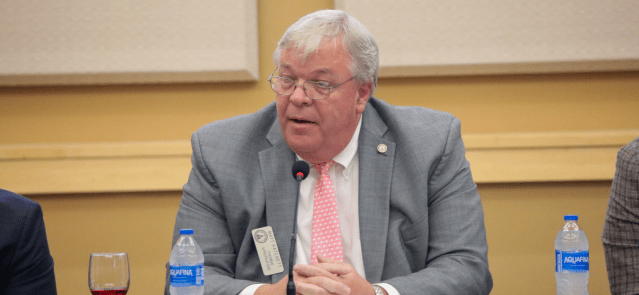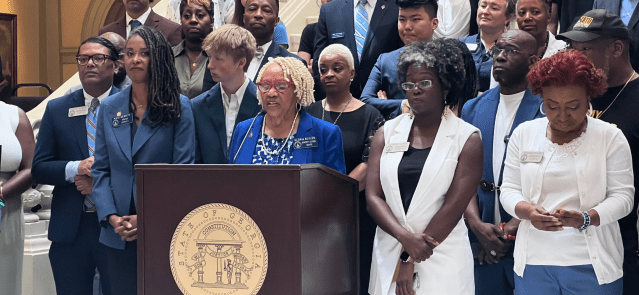Stay ahead of the curve as a political insider with deep policy analysis, daily briefings and policy-shaping tools.
Request a DemoGeorgia’s Vidalia Onion Committee interim executive director on the $150M industry & her favorite recipe

A Vidalia onion field in Georgia. (Photo courtesy of the Vidalia Convention & Visitors Bureau)

Georgia takes pride in its Vidalia onions, a flavorful and cherished crop that has become synonymous with the region. A beloved culinary treasure, the Vidalia onion captivates the hearts of foodies, chefs and Georgians alike.
As a cornerstone of Georgia’s economy, this onion varietal flourishes across roughly 12,000 dedicated acres. Each year, growers diligently pack and ship a whopping 200 million pounds of Vidalias, injecting over $150 million in farm gate value (the market value minus the selling costs) into the state’s financial landscape.
This year, get ready to savor the sweetness as the eagerly-awaited pack date rolls around on April 17. Determined by the Georgia Department of Agriculture in collaboration with the Vidalia Onion Committee, this date marks the official kickoff for packing and shipping Vidalias to retailers.
At the heart of this thriving, intriguing industry is the Vidalia Onion Committee, a membership organization that ensures the promotion, research, and high standards of Vidalia onions are maintained. One of the key players in this endeavor is Chelsea Blaxton Page, the interim executive director of the committee.
Vidalia onions are grown in a designated region in Georgia, which encompasses 13 full counties and parts of seven others. It is not possible for a grower from Texas or any other state outside of the designated region in Georgia to label their sweet onions as “Vidalia” onions, even if they were to become members of the committee.
State Affairs had the opportunity to sit down with Blaxton Page — who has been with the committee for six years, mainly working on “the compliance side of things” — to discuss her background, the crucial role the committee plays in supporting and regulating the industry and the future prospects of Vidalia onions in Georgia.
The conversation has been edited for length and clarity.
Q. So, for an onion to be labeled a Vidalia onion, they need to pay the Vidalia Onion Committee?
A. For Vidalia onion growers to label their onions Vidalia onions, they have to pay into our committee. … For every 40 pounds that the grower sells, they have to pay into the committee 13 cents. … So I just make sure they’re turning in the correct amount of money. That funds our entire program. First, they have to register with the State of Georgia, the Georgia Department of Agriculture. Once they’ve registered, they pass that information along to us. And that’s how we know there’s a new grower.
We have a research center with the University of Georgia. And when these seed companies come up with these new varieties, they have to be studied at our research center for three consecutive years before the growers can grow that type of seed. So we have a list. Every year, there are some added, there are some taken off. And for it [the onion] to be qualified as a variety, it has to be an approved variety. You can’t just go to Lowe’s and buy sweet onion and call it a Vidalia onion. It has to be registered with the State of Georgia and it has to be an approved variety.

Q. What do you guys do with the money you get? Where does it go? Does the government provide any funds?
A. The U.S. Department of Agriculture oversees our programs. [However,] we don’t [receive funding from the USDA] unless it’s through a grant, like a specialty crop block grant. Most of the things we do are funded through the assessments that are collected. [From the money we get] we fund the marketing. Every year, that’s $300-and-some-thousand dollars. We fund the research, which is normally around $250-ish [thousand.]
Q. How does the Vidalia onion industry impact Georgia’s economy as a whole? Is there any competition with Georgia’s Vidalia onion industry, like from Texas, which also grows sweet onions?
A. Farm gate value, the last time I looked, it was $150 million. So it brings a lot of money into our state. [Texas’s growing] season is not the same time as ours. We don’t really see ourselves in competition with anyone. We just focus on [ourselves.]
Q. The “Vidalia” name is copyrighted and the Vidalia Onion Committee is quite strict in enforcing it. Can you elaborate on the importance of the name and the measures taken to protect its integrity?
A. Actually, the State of Georgia owns the name “Vidalia” onion. We obviously monitor it, but we do that so there can’t be [knockoff] onions grown in California. And then they take from our popularity and try to use their onion as a Vidalia onion and label it as that, which is illegal. There are fines that come along with that. So if someone calls in and says there’s a grocery store in California, and says Vidalia onions are grown in California, that complaint comes to me. And then I forward that on to the State of Georgia.
Q. Can you share your favorite Vidalia onion recipe with us?
A. Oh, gosh, there’s so many. I love a good Vidalia onion ring. At the first of the spring, everybody’s outside grilling burgers, hot dogs, onion rings, or a Vidalia onion dip. There’s plenty.
Q. Can you tell us about any Vidalia onion-related events or festivals in Georgia that help to promote the industry and engage with the community?
A. So every year, the city of Vidalia puts on the Vidalia Onion Festival, and this year it’s actually going to be [April 20-23]. We always have an onion-eating contest, obviously. We have a recipe contest. This year, there’s going to be three nights of concerts. We’ll have a street dance. We have arts and crafts. There’s a number of fun things to do during that time. … We have visitors from all over the country. We had over 30,000 visitors last year. That’s not including the people that are from our area. That’s just from other cities.
Q. How do you envision the future of the Vidalia onion industry in the next 5 to 10 years?
A. I don’t see it changing a whole lot. I mean, other than the next generation, really. Several [farmers] are multigenerational farmers. We do have a few that are first-generation farmers and it’s always neat to see because it is a tough industry. If you can last a few years, you’ve made it in but the majority of the growers are generational growers. Vidalia onions are pretty sustainable.
The initial seed is planted by a tracker. From there on, everything’s done by hand. So after the initial seed is planted, the plant grows, and then we transplant those plants to another field. Then when it’s time to harvest those onions, the digger goes under the roots and pulls them up. We have H-2A workers who come in and cut the tops and bottom. Then [the onions] go into the packing facility and then into the box.
Rohan Movva is State Affairs’ intern writer in Georgia. A lifelong native of the Peach State, he’s proudly rooted in Georgia’s rich culture and charm.
Do you have a favorite Vidalia onion recipe? Send it to us at [email protected] for a chance to be included in our weekly newsletter!
Twitter @STATEAFFAIRSGA
Facebook @STATEAFFAIRSUS
Instagram @STATEAFFAIRSGA
LinkedIn @STATEAFFAIRS
Professionals still face licensing delays amid state’s transition to online system
The Gist Georgia’s professionals and business owners are still struggling to obtain professional licenses in a timely manner. As the Secretary of State’s Office rolls out its new Georgia Online Application Licensing System to expedite the process, the efficiency of this new process is being put to the test. What’s Happening Thursday morning at the …
Controversy over AP African American Studies class grows
Rashad Brown has been teaching Advanced Placement African American Studies at Atlanta’s Maynard Jackson High School for three years. He’ll continue to do so — even though the state’s top education official removed it from the list of state-funded course offerings for the upcoming school year. While Brown prepares to start teaching his class on …
Students, teachers, lawmakers blast decision to end AP African American history classes
ATLANTA — A coalition of lawmakers, civil rights leaders, clergy, educators and students Wednesday called on the state’s education czar to rescind his decision to drop an advanced placement African American studies class from the state’s curriculum for the upcoming school year. “This decision is the latest attack in a long-running GOP assault on Georgia’s …
Kamala Harris’ presidential bid reinvigorates Georgia Democrats
Georgia Democrats have gained new momentum heading into the November election, propelled by President Joe Biden’s decision to bow out of his reelection bid and hand the reins to Vice President Kamala Harris. The historic decision, announced Sunday, is expected to prove pivotal in the national and state political arenas and breathe new life and …





